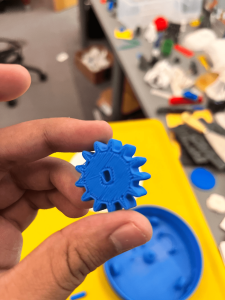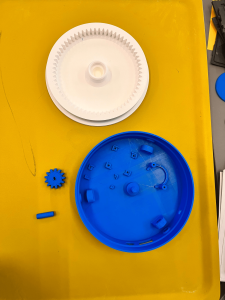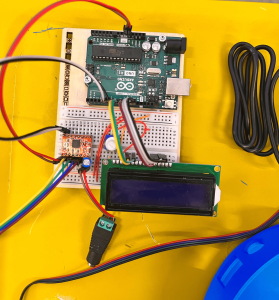I remember the day I first laid eyes on that clunky, awkward, yet fascinating automated burrito-making machine in the local toy store. It was love at first sight! I knew I had to make it mine, but alas, my piggy bank held only a handful of nickels and a couple of lint balls. Little did I know that my passion for robotics would lead me to a journey full of laughter, tears, and making the lives of hundreds of passionate photogrammetry hobbyists like me easier by creating an affordable DIY Arduino turntable.
Fast forward to 2023, where I found myself rotating an 80 thousand-year-old cave bear tooth by one degree increments and taking 600 pictures, all with just 2 hands (which took me 4 hours and gave me 2 days of back pain) in our college Makerspace. I found myself daydreaming about the kind of robot I would create if only I had the skills of Tony Stark. And then, soon afterward, while I was surfing the internet on how to make photogrammetry pictures better optimized for 3D scanning, I stumbled upon a YouTube photogrammetry tutorial and found out that there was a ”thing” called “turntables.” To my sadness, it cost $150. And that was my light-bulb moment. I thought, “Why not give it a try?” As I saw my Makerspace friends clumsily rotate a plastic hangman for 3D scanning, I had an epiphany – what if I built an AFFORDABLE automatic turntable to do the job for us?
With the enthusiasm of a mad scientist, I proposed the idea to David, our Makerspace Program Manager and he immediately approved the idea and sent me a couple of resources to start with (thanks, David, for being so supportive). I dove headfirst into the world of turntables that people had previously made. I found Adrian Glasser–a professional computer scientist and a consultant–who had already made an almost similar prototype I was planning to make. Although Adrian’s project was pretty cool, it needed fancy components which were relatively expensive. I also found Brian Brocken, a passionate maker and 3D printer, whose turntable project stood out and inspired me a lot in the design of my prototype. While these works were a great sense of inspiration, my mind was lingering around the question of “how to make the design and features more efficient while keeping the device affordable and easy to build.”
The journey was fraught with challenges and unexpected twists, but I was determined to build the most magnificent, borderline-overengineered turntable the world had ever seen (just kidding!). I worked iteratively, and my first draft was a very basic model so that I could feel it with my hands and think about the build process I 3D printed a PLA (a type of 3D printing filament) base, a rotating platform , and some gears and bearings. After researching different approaches, I ordered my first set of electronic components and kept the total cost below $60 for this first version.
I decided to go with Arduino Uno, a very easy-to-program and flexible microcontroller that will be the brains of my device. “Easy to build for everyone” was lingering in my mind when I chose the components. I got a stepper motor – which provides incremental motion, compared to a DC motor that provides a continuous motion – coupled with a physical motor driver to enable precise and sequential one-degree rotations with a super-low margin of error. To make the turntable more user-friendly, I added a simple LCD display and a rotary encoder for adjusting the rotation speed. After two weeks of assembly and testing, I had a fully functional circuit.
Now it’s time to code! The hardest part while coding was finding the library file on the internet that corresponded to my particular stepper motor. It took me 4 hours just to find the library and start coding! Phew…
I kept writing code for a week and then moved on to testing my code. Overcoming the challenges of building my robotic turntable was like conquering Mount Everest. I spent hours troubleshooting the Arduino code, sifting through lines of syntax until my eyes crossed. But, much like a robot phoenix, I rose from the ashes, armed with patience, persistence, and an endless supply of coffee. After a few weeks of tinkering and testing, I finally had a circuit and a working code that I marked as a BIG CHECKPOINT for the project.
The spring semester gradually came to an end, and the turntable project will take a summer vacation. But next semester, the first prototype of the turntable is going to see the bright light of the earth.
Next Steps
- Using Fusion360 to design an easy-to-print downloadable 3D model (stl file)
- Using Infra-Red (IR) sensors to automate the camera shutter click with each one-degree rotation of the turntable, so that our Makerspace friends can leave the automated turntable working (extra hours!) overnight **insert cruel laugh**
- Sharing the technical details and building process online to make it accessible to other Makerspace groups and hobbyists around the world. This can be done through posting a follow-up blog with all the technical details. For example, I hope to publish step-by-step instructions, along with the final list of parts (with URLs), my custom Arduino code, link to the software library that corresponds to my stepper motor, and post downloadable .stl files for printing my custom 3D models to complete this project.
Affordability
I hope to keep the project affordable and my goal is for all costs to be under $70.
Conclusion
During this journey, I learned the importance of patience, collaboration, and perseverance. Building a robotic turntable from scratch is not a one-person job, and I found myself relying on the support and expertise of my fellow Makerspace friends. Together, we shared our knowledge and skills, which not only allowed me to build a better turntable but also contributed to the overall growth and development of our Makerspace community. I enlisted the help of my fellow Makerspace comrades, who offered their own unique brand of wisdom, ranging from programming tips to advice on how to make the turntable levitate. (Note: do not try to make your turntable levitate. It’s a bad idea.)
The Arduino turntable project wasn’t just about creating a cool gadget – it was about embracing my love for robotics and the creative process. In the end, I learned that a healthy dose of humor, imagination, and the willingness to make things up as you go can lead to some truly spectacular results.
Today, my beloved half-constructed Arduino turntable takes pride of place on the little yellow Makerspace table, a constant reminder of progress, the power of imagination, and the beautiful chaos that comes with it. So, dear reader, I encourage you to explore your own interests, whether that’s robotics or any other field that sparks your curiosity. Be open to surprises, maintain a sense of humor when facing challenges, and always remember that amazing innovations often start with bold ideas.



